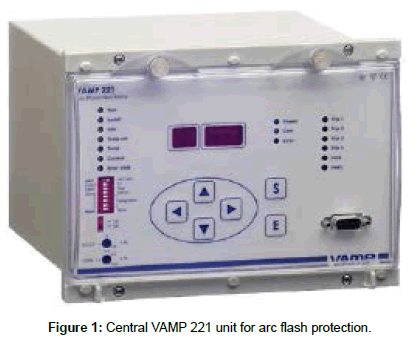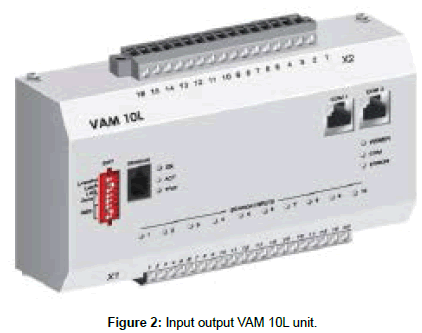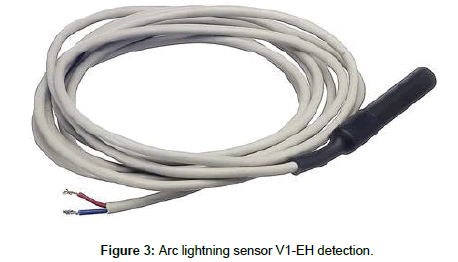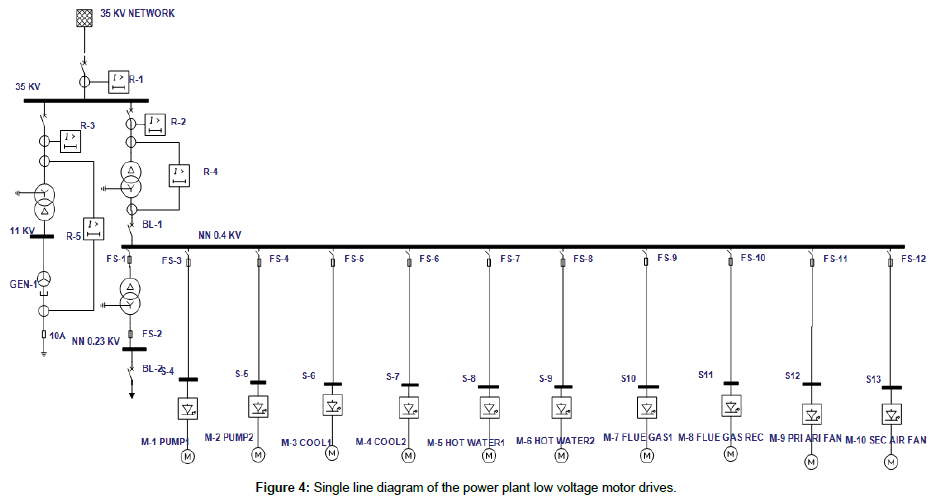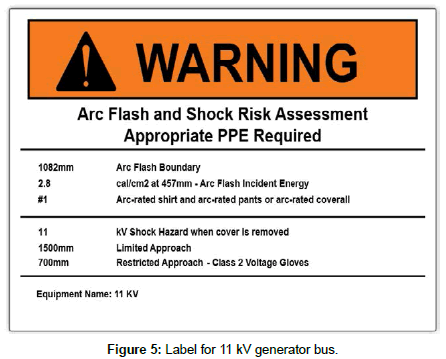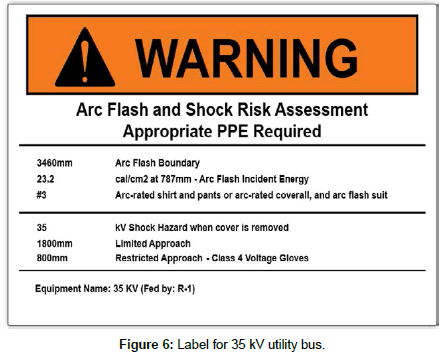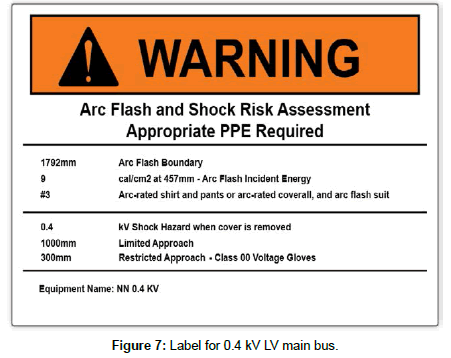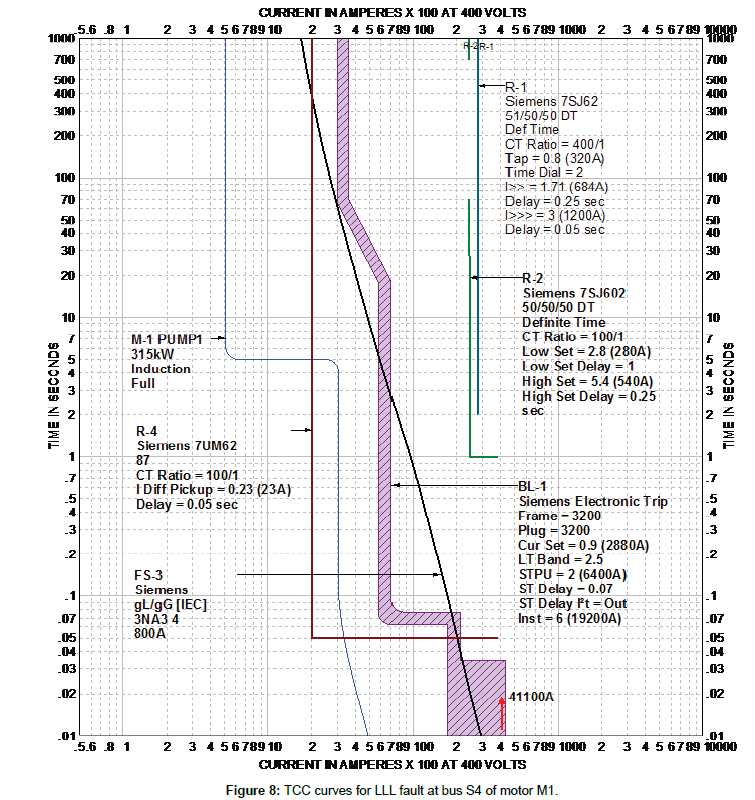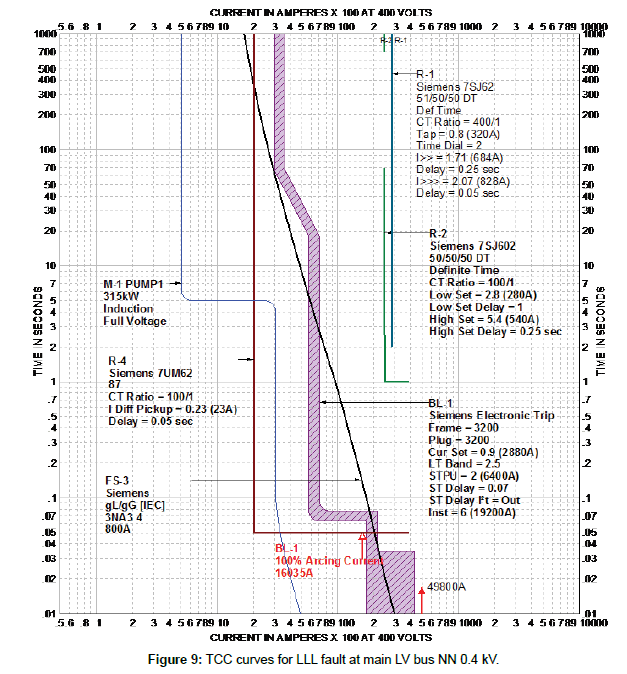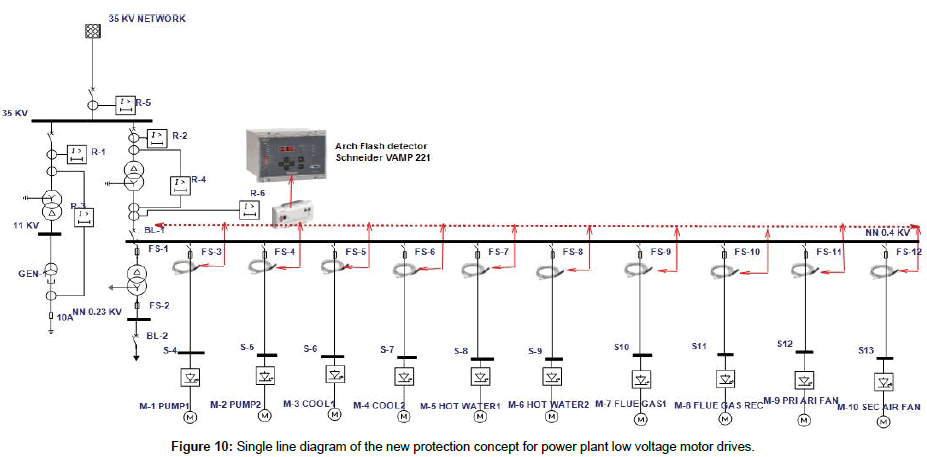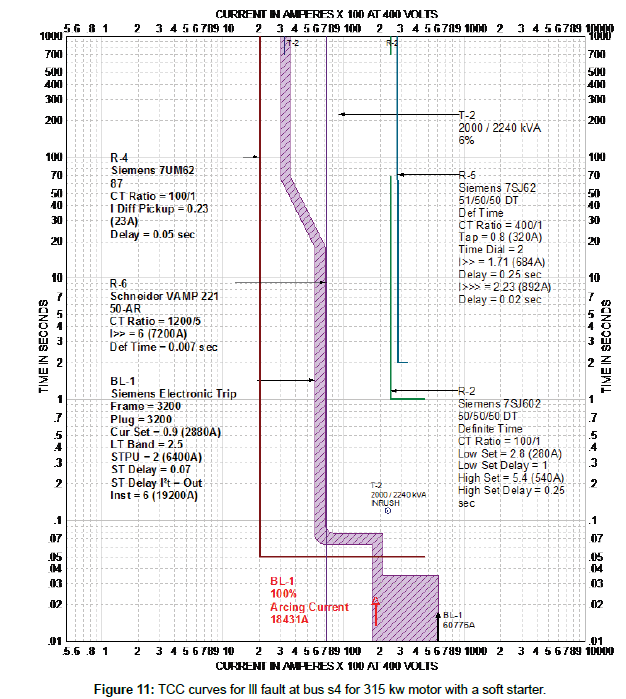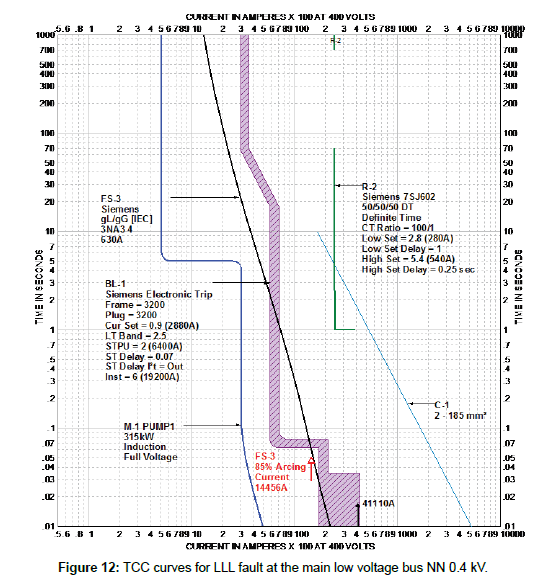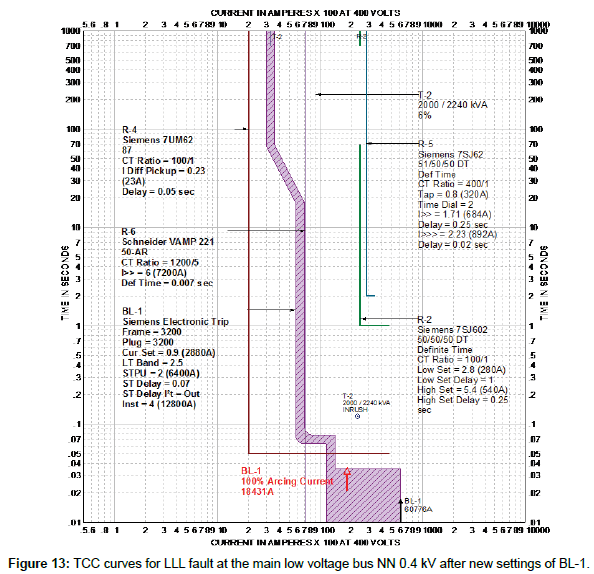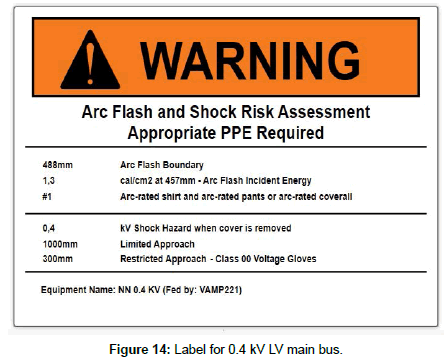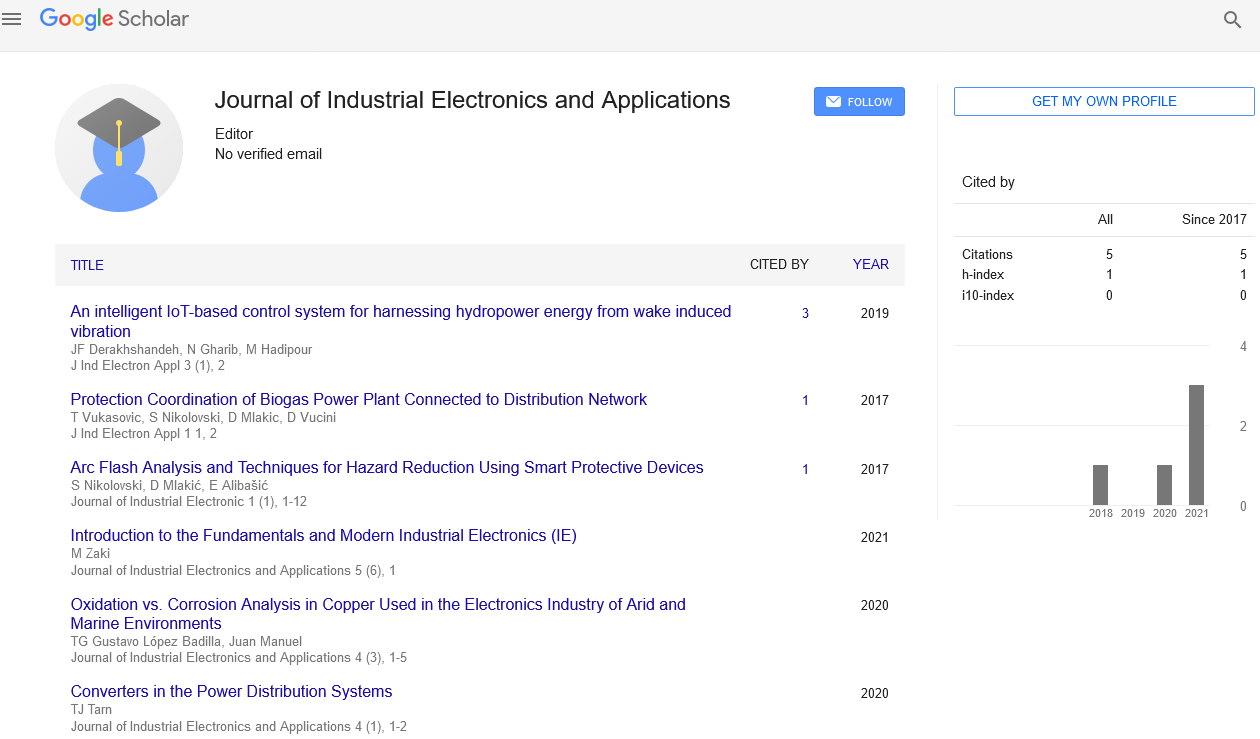Research Article, J Ind Electron Appl Vol: 1 Issue: 1
Arc Flash Analysis and Techniques for Hazard Reduction Using Smart Protective Devices
Srete Nikolovski*, Dragan Mlakic and Emir Alibasic
Department of Power Engineering, University of Osijek, Osijek, Croatia
*Corresponding Author : Srete Nikolovski
Department of Power Engineering, University of Osijek, Osijek, Croatia
Tel: +3850912246005
Fax: 385 31 2246005
E-mail: srete.nikolovski@etfos.hr
Received: December 05, 2017 Accepted: December 10, 2017 Published: December 26, 2017
Citation: Nikolovski S, Mlakic D, Alibasic E (2017) Arc Flash Analysis and Techniques for Hazard Reduction Using Smart Protective Devices. J Ind Electron Appl 1:1.
Abstract
This paper presents an arc flash risk assessment taking care of the protection device coordination procedure in order to reduce incident arc flash energy at low voltage busbars in a biomass power plant. The mitigations were measured and presented to reduce incident arc flash energy using the appropriate smart protection device software. A short circuit analysis is performed to calculate the values of short circuit currents and compute arc flash energy dissipated at busbars at low voltage busbars in the biomass power plant. An arc flash can cause damages to electrical equipment and personnel. In this paper, three main techniques were considered, namely arc flash prevention, prediction and monitoring, detection and reduction using a smart arc flash module and proper protection coordination software. A practical sample case is presented for low voltage busbars in one biomass power plant in Croatia.
Keywords: Arc flash; Short circuit; Mitigation measures; Protection devices; Time current coordination; Low voltage busbars; Biomass power plant
Introduction
Our increased dependence on renewable energy sources and a need to improve the reliability of distribution networks has resulted in a lower tolerance of any power outage and higher security for personnel and equipment. Consequently, it has created a need for electrical workers to perform maintenance work on energized electrical equipment (live working conditions). In addition to the electrical shock hazard that results from a direct contact of live conductors with a body, workers are also exposed to the injury risk due to accidental initiation of electric arcs. Arc flash injuries can occur without any direct contact with energized parts. This arc flash hazard, due to arcing faults, has existed from the beginning of the electric power industry but it has only recently been addressed as a specific problem and hazard in electrical safety programs and national safety codes.
Electrical environment is changing fast and the power industry is considering innovations in the electrical systems designs, equipment and protection aiming to limit the arc flash hazard as it is detrimental to the worker safety. This raises new issues in the power system design, analysis, and computation and simulations [1].
Protection devices and new techniques for the arc flash detection and fast elimination are essential for the electric power industry analysis in order to avoid damages due to an arc flash produced by short circuit currents [2]. Arc flash hazards can result from many factors, including dropped tools, accidental contact with electrical systems, build up of conductive dust, corrosion and inadequate work procedures. An arc is produced by a flow of electric current through ionized air after an initial flashover or short circuit resulting in ash that can cause significant heating and burn injuries.
An arc flash is very dangerous because it produces dangerous levels of radiant heat energy capable of causing severe burns and ignition of clothing, which can result in treatment requiring years of skin grafting, rehabilitation and even death. Spray droplets of molten metal, with the explosion distributing the molten metal and shrapnel produced by the arc can be expanded to a large area. Produced blast pressure waves can blow workers across the room and knocked them off ladders. Arc flash can result in personnel deafness [3].
The arc flash analysis and hazard assessment are differently normed in the USA and EU countries. In the USA, IEEE 1584-2002 entitled “IEEE Guide for Performing Arc-Flash Hazard Calculations” is standard. It provides a methodology for calculating prospective arc flash hazards [4]. Based on the test data, the IEEE 1584 committee defined empirical equations to calculate arc flash incident energy for AC systems. Although OSHA-Occupational Safety and Health Act of 1970 has not specially addressed the arc flash, the existing and new provisions impact are as addressed:
OSHA 1910.132 (d), and 1926.28 (a). OSHA considers NFPA 70E a consensus industry standard for assessing arc flash standards [5]. An employer is responsible to:
1) assess the hazards in the work place;
2) select, have and use the correct PPE;
3) document the assess distance.
OSHA considers arc flash assessments that follow NFPA 70E. They have to be in line with OSHA requirements and protect workers from electrical safety hazards [6,7].
In the EU, IEC standard does not pay a special attention to the arc flash energy calculation but it has a standard for PPE-personnel protection equipment for arc flash protection equipment testing. IEC 61482-1 and the identical EN 61482-1 are split into two parts which cover the methods for testing of clothing fabrics and garments that are designed to protect against arc flashes.
IEC 61482-1-2 and the identical E 61482-1-2, which now supersedes ENV 50354, have become known as the “box test”. There are two test method versions - the “material box test”, which includes the heat transfer measurements, stoll curve differential analysis, and the “garment box test”, which requires only a visual assessment of the garment performance [8].
The box-test standard defines two testing conditions, namely Class 1 and Class 2:
Class 1 tests at an arc current of 4 kA and arc duration of 500 ms;
Class 2 tests at an arc current of 7 kA and arc duration of 500 ms.
This paper presents an arch flash mitigation technique which can be used in real practice and a practical sample case analysis performed in one biomass power plant [9].
Arc Flash Analysis
Arc flash hazard studies require the knowledge of both the electrical power plant facility and the power plant electrical protection. Arc flash studies can be considered as a continuation of the short circuit and coordination aspects of a power plant since the results for each are required to assess flash hazards. The effort required to perform an arc hazard assessment is greatly reduced by closer integration between the short circuit, protective device coordination, and the arc-flash software.
The greatest single effort in performing an arc flash study is in data collection. For a system with up-to-date one-line diagrams, data collection can take from 25-40 percent of the study effort. The main difference between an arc hazard assessment and other studies is that the system needs to model in more details increasing the data collection time and study effort. If the equipment has the potential to be worked on while energized, it should be assessed. This includes branch circuits in data centers, panels and switchboards being served by smaller (<500 kVA) transformers at 400 V. Panels and switchboards rated 230 V or less can be ignored if the service transformer is less than 125 kVA.
This paper describes a procedure for the arc flash mitigation using special optical sensors and a digital relay with proper protection devices coordination in a real sample case at one biomass power plant low voltage facility. Performing an arc flash hazard assessment using the power system analysis software and measures for mitigating the effect of an arc flash are presented. In order to minimize space requirements, it will be assumed that the power plant is modeled in EasyPower and that it has performed a short circuit and protective device coordination study for the real designed case. The necessary modification of a relay setting and protection device coordination was performed and time-current curves –TCC (t-I) were presented for two cases:
1) high arc flash energy and wrong protection device settings;
2) proper protection device coordination, arc flash optical detector and an appropriate digital relay.
For plants with a simple radial service from the utility, only one mode of operation typically exists – normal. However, for larger plants, there may be multiple modes of operation.
These may include:
• multiple utility sources that are switched on or off;
• multiple generator sources that are operated in parallels or isolation depending on the system configuration;
• emergency operating conditions. This may be with only small backup generators;
• maintenance conditions where short circuit currents are low and trip time high;
• parallel feeds to switchgear or MCCs;
• tie breakers which can be operated open or closed;
• large motors or process sections which are not in operation.
What is important to acknowledge is that each of these conditions may change the level of short circuit current, which in turn changes the clearing time of the protective devices. These changes can have a significant impact on the arc flash hazard.
After the system model is built and the operating modes determined, the following procedures are used to determine arcing fault incident energies:
• determine bolted fault (short circuit) currents at each bus in the system;
• use calculated currents to enable a protective device;
• conduct coordination study and set system relay settings
• check trip settings. Settings are typically determined by plotting protective devices on time current curves (TCCs);
• determine arcing fault currents at each bus in the system using IEEE-1584 or NFPA-70E equations. Note that different equations or multipliers are used for voltages <1.0 kV, 1.0 kV <kV <15.0 kV, open air, inside box and various system parameters;
• apply arcing currents and breaker/relay trip times to each device to determine arc hazard incident energies, arc-flash boundaries, working distances and PPE requirements.
Before running the actual analysis, a user should determine the parameters the study will be based on. These include working distances, units of measurement, threshold boundaries and the calculation standard or the “equations” for the analysis. The arc flash boundary and associated protection requirements are based on the incident energy levels available to the person’s chest or face, not the hands or arms. The degree of injury depends on the percentage of the person’s skin that is burned and the critical nature of the burn. Obviously, the head and chest areas are more critical to survival than fingers or arms. Appropriate working distances for most operations can be calculated by placing your below at your side and extending your hand to the equipment [10-13].
Arc Flash Mitigation Techniques
Arc flash incident energy is defined as the amount of energy impressed on a surface - a specific distance away from the source during an electrical arc event. It is sometimes called surface energy density. Incident energy is measured in joules per centimeter squared (J/cm2) or in calories per centimeter squared (cal/cm2). The arc flash boundary is defined as the distance from the arc source where the onset of second degree burns can occur. This is typically defined by medical researchers as 1.2 cal/cm2 or 5.0 J/cm2. Some researches indicate that up to 1.5 cal/cm2 can be used for exposure less than 6 cycles (0.1 seconds).
The arc flash procedure and technique for prevention and mitigation can be divided in two activities and four groups of actions. Two activities can be divided in pre-arcing and post-arcing activities.
Pre-arcing activities are:
1. Arc prevention which includes:
• de-energized work;
• reduced fault currents;
• training - safe work practices;
• maintenance;
• good design;
• Remote racking.
The first measure includes de-energizing equipment (if possible), labeling equipment and training personnel, minimizing risk with good safety practices, moving people further away, closing and tightening door latches or door bolts before operating a switch, designing hazard out (safety by design, reduce available fault current and speed up clearing times of protective devices).
2. Arc prediction monitoring which includes:
• partial discharge;
• smoke;
• acoustic;
• temperature.
Post-arcing activities are:
1. Arc containment which includes
• Arc resistant/explosion proof enclosures (panel boards, switchboards, motor control centers and switchgear);
• Personal Protective Equipment (PPE).
Arc detection which includes
• current/voltage signal analysis;
• ground fault;
• lightning sensing.
Arc elimination which includes
• shorting bar – arc mitigation;
• creating a parallel arc.
Arc flash reduction which includes
• reducing arc time;
• differential protection;
• zone selective interlocking;
• maintenance switch;
• new protection devices.
This paper will elaborate on the post-arcing measures lightning sensing relay, differential protection and new protection devices. New protection device will include proper protection device coordination and resetting protecting device from a base case to reduce arc flash hazard.
Technical data of the generator are given in Table 1.
| Type | SIEMENS 1DU1549-8AE02-Z |
|---|---|
| Rated power | 12158 kVA |
| Vector group | Delta |
| Rated voltage | 11000 +/-10% |
| Frequency | 50 Hz |
| Rated rotor speed | 1500 min-1 |
| Rated stator current | 638 A |
| Power factor | 0.85 ind. |
| Direct axes synhronous reactance Xd | 143,2 % |
| Transient reactance X’d | 17.1% |
| Subtransient reactance X’’d | 10.8 % |
| Inverse reactance X2 | 15.4% |
| Quadratic axes synhronous reactance Xq | 129.9% |
| Transient reactance X’q | 129.9% |
| Subtransient reactance X’’q | 11.9 % |
| Zero sequence reactance Xo | 5.8% |
Table 1: Synchronous generator data.
Technical data of the block transformer are provided in Table 2.
| Type | SIEMENS TDQ -134A03S1N-99 |
|---|---|
| Rated power | 13000 kVA |
| Rated voltage | 35/11 kV +/-2.5% |
| Frequency | 50 Hz |
| Vector group | YNd11 |
| Short circuit voltage uk | 7.5% |
| Secondary side treatment | grounded |
| Short citcuit losses Pcu | 80.00 kW |
| Open circuit losses PFe | 14.00 kW |
Table 2: Block transformer data.
Technical data of the transformer for the power plant own consumption are illustrated in Table 3
| Type | SIEMENS TDQ-203A03S5A-99 |
|---|---|
| Rated power | 2000 kVA |
| Rated voltage | 35/0.4 kV +/-2.5% |
| Frequency | 50 Hz |
| Vector group | Dyn5 |
| Short circuit voltage uk | 6 % |
| Secondary side treatment | grounded |
| Short circuit losses Pcu | 20.00 kW |
| Open circuit losses PFe | 2.10 kW |
Table 3: Transformer data for own consumption.
Technical motor data are given in Table 4.
| Motor | Rated power (kW) | Rated voltage (V) | Rated current (A) | Speed (1/min) |
|---|---|---|---|---|
| M1-Feedwater pump | 315 | 400 | 534 | 3552 |
| M2-Feedwater pump | 315 | 400 | 534 | 3552 |
| M3-Main cooling water pump | 250 | 400 | 438 | 1349 |
| M4-Main cooling water pump | 250 | 400 | 438 | 1349 |
| M5-Hot water circulation pump | 160 | 400 | 265 | 2586 |
| M6-Hot water circulation pump | 160 | 400 | 265 | 2586 |
| M7- Flue gas fan | 250 | 400 | 427 | 1395 |
| M8- Flue gas recirculation fan | 160 | 400 | 265 | 3137 |
| M9- Primary air fan | 200 | 400 | 330 | 3126 |
| M10- Secondary air fan | 90 | 400 | 158 | 1947 |
Table 4: Motors data.
As it was mentioned, the latest state-of-art technology will be used for the arc flash detection using an optical sensor and digital protection devices. For the arc flash detection, optical light sensors and VAMP 221 digital relay are used. VAMP 221 is an easily adaptable arc protection system for the protection of distribution systems and power plants. It significantly reduces the risk of potential personnel damage, material and production losses caused by arc fault. VAMP 221characteristics are:
• system operating time 7 milliseconds;
• accurate location of arc fault;
• four selective protection zones;
• self-supervision of the entire system;
• system cabling with standard cables;
• automatic system configuration;
• phase current measuring;
• earth-fault current measuring.
As shown in the following figures, Figure 1 illustrates the main arc flash protection relay, Figure 2 input output unit and Figure 3 arc lightning sensor detection.
VAM 10L accommodates up to 10 arc sensors and indicate all active sensors. Protection zone addresses a maximum of 4 zones detachable to external wiring terminal blocks. VAM 10L can be connected to a portable arc sensor (3LX and 3L). It can be placed in a switchgear and connect with arc sensors using intra-unit cables.
An arc lightening sensor can detect strong light and transform it to a current signal in the sensor VAM 10L which transfers the current signal to the central unit. Standard cable can be of lengths 6m and 20m. The sensor type offers a cost-effective arc protection solution. The sensor can, for example, be installed in a tube so that the active light detector sees the monitored zone. Self-supervised arc sensor is used. For the protection in distribution systems and power plants, LVPCB-low voltage power circuit breakers, MCCB-molded case circuit breakers, ICCB-isolate case circuit breakers, HV breakers with secondary protective relays can be used.
Sample Case of Biomass Power Plant
A distribution generator at the biomass power plant connected on 35 kV distribution network with ancillary consumption at 0.4 kV level was modeled completely with all components - generator, transformers, cables, CMT (current measuring transformers), busbars, VMT (voltage measuring transformers), digital relays, breakers, fuses and electric motor drives [10].
All data are entered and presented in online diagram in Fig. 4. The data for relay settings, breakers and fuses are used from the project documentation of the biomass power plant UNI Viridas rated power 10 MW and the pre-setting values are presented in Table 5.
| Rel. | Protection devices settings | |||
|---|---|---|---|---|
| Type of a relay | Setting | Setting | Setting | |
| R1 | SIEMENS 7SJ62 |
I>320 A, DT t=2 s |
I>> 684A, DT t =0.25 s |
I>>>1200A, DT, t=0.05 s |
| R2 | SIEMENS 7SJ62 |
I>280 A DT, t =1 s |
I>>540 A, DT, t=0.25 |
|
| R3 | SIEMENS 7SJ62 |
I>300 A DT, t =1 s |
I>>540 A, DT, t=0.25 |
|
| R4 | SIEMENS 7UM62 |
Id>23A DT, t=0.05s |
||
| R5 | SIEMENS 7UM62 |
Id>1203A DT, t=0.05s |
||
| BL1 | SIEMENS LV breaker |
LSI I>2880 A LT=2.5 |
I>>6400 A, ST delay t=0.07s |
I>>>19200 A, instantaneous |
| F3 | SIEMENS HV Fuse | IEC I=800 A |
||
| F4 | SIEMENS HV Fuse | IEC I=800 A |
||
| F5 | SIEMENS HV Fuse | IEC I=630 A |
||
| F6 | SIEMENS HV Fuse | IEC I=630 A |
||
| F7 | SIEMENS HV Fuse | IEC I=500 A |
||
| F8 | SIEMENS HV Fuse | IEC I=500 A |
||
| F9 | SIEMENS HV Fuse | IEC I=630 A |
||
| F10 | SIEMENS HV Fuse | IEC I=500 A |
||
| F11 | SIEMENS HV Fuse | IEC I=500 A |
||
| F12 | SIEMENS HV Fuse | IEC I=300 A |
||
Table 5: Relay settings data.
A single line diagram of the biomass power plant is presented in Figure 4.
After performing a short circuit analysis 3PF for all buses, the incident energy for arc flash is presented for all buses. The buses colored red are above recommended values according IEEE-1584 calculation standards and it is very dangerous to work on them. Extremely dangerous working situation is on LV bus 0.
Figure 5 shows that the incident arc flash energy is above the limited values and can be dangerous for working personnel at some buses. For all such devices, labels, such as the ones in Figures 6-8 according to the employer’s personnel protective equipment (PPE), in compliance with the 89/686/EEC directive, can be printed.
Table 6 presents the results of not well coordinated protection devices and protective system for mitigation and reduction of arc flash incident energy. It clearly shows that the main enclosed LV busbar 0.4 kV has a high amount of extremely dangerous incident energy of 89.9 cal/cm2, arc flash, max boundary of 8557.4 mm and minimum working distance of 457.2 mm. It is extremely dangerous for personnel to work on that busbar. Also, the generator 11 kV bus and 35 kV buses have high values of the arc flash incident energy as well as three busbars of motor drives M1, M2 and M4 as shown in Figure 5 and Table 6.
| Arc Fault Bus Name |
Arc Fault Bus |
Upstream Trip Device | Upstream Trip Device | Equip Type | Arc Gap (mm) | Bus Bolted Faul (kA) | Bus Arc Fault (kA) | Trip Time (sec) | Opening Time (sec) | Arc Time (sec) | Est Arc Flash Boundary (mm) | Working Distance (mm) | Incident Energy (cal/cm2) | Required Clothing Class |
|---|---|---|---|---|---|---|---|---|---|---|---|---|---|---|
| 11kV | 11 | 50 | Other | 153 | 10.882 | 10.546 | 0 | 0.08 | 1081.9 | 457.2 | 2.8 | #1 | ||
| 51-MIN | Other | 153 | 10.882 | 10.546 | 0 | 0.44 | 6238.7 | 457.2 | 15.ožu | #3 | ||||
| 51-INT | Other | 153 | 10.882 | 10.546 | 0 | 0.58 | 8287.1 | 457.2 | 20.1 | #3 | ||||
| 51-MAX | Other | 153 | 10.882 | 10.546 | 0 | 0.75 | 10792.8 | 457.2 | 26 | #4 | ||||
| 35kV | 35 | R-1 | 51/50/50DT | Other | 254 | 4.219 | 4.219 | 0.05 | 0.14 | 0.19 | 3459.9 | 787.4 | 23.vlj | #3 |
| NN 0.4kV | 0.4 | INST | Panel | 32 | 49.831 | 19.793 | 0 | 0.05 | 1792.5 | 457.2 | 9 | #3 | ||
| ST-MIN | Other | 32 | 49.831 | 19.793 | 0 | 0.19 | 4436.7 | 457.2 | 34.1 | #4 | ||||
| ST-INT | Other | 32 | 49.831 | 19.793 | 0 | 0.33 | 6454 | 457.2 | 59.3 | ExtDanger | ||||
| ST-MAX | Other | 32 | 49.831 | 19.793 | 0 | 0.5 | 8557.4 | 457.2 | 89.8 | ExtDanger | ||||
| NN 0.23kV | 0.23 | FS-2 | Panel | 32 | 1.043 | 0.766 | 0.019 | 0 | 0.019 | 44.2 | 457.2 | 0.04 | #1 | |
| S-4 | 0.4 | BL-1 | Panel | 32 | 41.107 | 17.007 | 0.077 | 0 | 0.077 | 1104.6 | 457.2 | 4.tra | #2 | |
| S-5 | 0.4 | BL-1 | Panel | 32 | 41.268 | 17.059 | 0.077 | 0 | 0.077 | 1107.1 | 457.2 | 4.tra | 2 | |
| S-6 | 0.4 | FS-5 | Panel | 32 | 41.192 | 14.479 | 0.046 | 0 | 0.046 | 695.4 | 457.2 | 2.2 | #1 | |
| S-7 | 0.4 | FS-6 | Panel | 32 | 42.034 | 14.712 | 0.09 | 0 | 0.09 | 1108.2 | 457.2 | 4.tra | #2 | |
| S-8 | 0.4 | FS-7 | Panel | 32 | 38.06 | 13.604 | 0.016 | 0 | 0.016 | 327.3 | 457.2 | 0.7 | #1 | |
| S-9 | 0.4 | FS-8 | Panel | 32 | 37.522 | 13.453 | 0.017 | 0 | 0.017 | 331.8 | 457.2 | 0.7 | #I | |
| S10 | 0.4 | FS-9 | Panel | 32 | 39.819 | 14.098 | 0.081 | 0 | 0.081 | 993 | 457.2 | 3.kol | #1 | |
| S11 | 0.4 | FS-10 | Panel | 32 | 39.819 | 14098 | 0.015 | 0 | 0.015 | 313.9 | 457.2 | 0.7 | #1 | |
| S12 | 0.4 | FS-11 | Panel | 32 | 41.192 | 14.479 | 0.014 | 0 | 0.014 | 304.9 | 457.2 | 0.7 | #1 | |
| S13 | 0.4 | FS-12 | Panel | 32 | 39.819 | 16.585 | 0.007 | 0 | 0.01 | 271.3 | 457.2 | 0.6 | #1 |
Table 6: Results of the arch flash analysis.
For the real sample case, LLL fault is performed at motor bus S4 in order to plot TTC (Time Current Curves) which includes the motor M1 curve, its protective fuse FS-3, LV breaker BL-1 on secondary side of a transformer, differential protection relay R4, overcurrent relay R2 and network reley R1 which will be presented prior to proper relay setting and coordination.
Figure 9 indicates that the protective coordination is acceptable since the first will trip fuse FS-3 for fault current of 41.1 kA at time 0.002 s and if it fails, the next will be LV breaker Bl-1 with the instantaneous time of 0.035s and after that, backap relay R2 on the primary side of the transformer with 1s time delay. It can be noticed that fuse FS-3 is 800A of the rated current is placed far more to the right side of the motor. So, we can select another fuse with lower current to reduce the arc flash incident energy at bus S4. Arcing current for LLL fault at the main LV bus 0.4 kV is presented at Figure 10. The bus is protected by LV breaker BL-1 and arcing current for 100% probability is 16.035 kA.
It is evident that the value of arcing current is on the left side of instantenous settings and will be triped at 0.07 s with LV breaker opening time of 2 cycles which is 40 ms. So, resseting BL-1 LSi characteristics or using a special arc flash relay for optical detection and very fast tripping will be required. New fuses, breaker, differential protection relay settings and a special arc flash protection devices VAMP 221 with I/O unit and optical sensor in each motor switchboard are used for the arc flash incident energy reduction as presented in Figure 11.
It is necessary to eliminate such a huge level of risk during the work on buses NN 0.4 kV, 11 kV, 35 kV and motor buses S4, S5 and S7; hence, it is necessary to rearrange the upstream fuse and relay settings of breaker BL-1 using the special arc flash relay detection VAMP 221. Lower rated values of fuses are chosen because they will protect motors and cables but they do not have an influence on motor starting curves. The TTC time-current (t-I) characteristics for that case is shown in Figure 12.
For these new settings, there are no problems since arcing current trips faster for motor M1 at 0.05s and the arc flash and incident energy is lower.
Figure 13 shows that the arcing current for LV breaker BL-1 is in line with the characteristics and the current will be tripped after 0.08s, which is in the ST delay domain. It is needed to rearrange the settings of instantaneous trip I>>> on lower value. I>>>=12 800 A with tripping time 0.03s.
For this setting, the arc flash energy for bus NN 0.4 kV is 6.6 kcal/ cm2, arc flash boundary 1455.5 mm, working distance 457.2 mm, and Personal Protective Equipment (PPE) requires clothing at level #2. Threshold for the arc flash energy is 4 kcal/cm2. Consequently, it is essential to reduce the energy to a lower value using the special arc flash relay VAMP 221 whose time of arc detection is 0.007s. Opening time of BL-1 breaker is 2 cycles as presented in Figure 13. Now all PPE requires clothing at level #1 which includes a fire shirt and fire pants. The final proposed relays settings for the case sample are given in Tables 7 and 8.
| Rel. | Protection devices settings | |||
|---|---|---|---|---|
| Type of a relay | Setting | Setting | Setting | |
| R1 | SIEMENS 7SJ62 |
I>320 A, DT t=2 s |
I>> 684A, DT t =0.25 s |
I>>>1200A, DT, t=0.05 s |
| R2 | SIEMENS 7SJ62 |
I>280 A DT, t =1 s |
I>>540 A, DT, t=0.25 |
|
| R3 | SIEMENS 7SJ62 |
I>300 A DT, t =1 s |
I>>540 A, DT, t=0.25 |
|
| R4 | SIEMENS 7UM62 |
Id>23A DT, t=0.05s |
||
| R5 | SIEMENS 7UM62 |
Id>1203A DT, t=0.05s |
||
| R6 | Schneider VAMP221 |
50 –AR | I>>7200A t=0.007 |
|
| BL1 | SIEMENS LV breaker |
LSI I>2880 A LT=2.5 |
I>>6400 A, ST delay t=0.07s |
I>>>12800 A instantaneous |
| F3 | SIEMENS HV Fuse | IEC I=630 A |
||
| F4 | SIEMENS HV Fuse | IEC I=630 A |
||
| F5 | SIEMENS HV Fuse | IEC I=500 A |
||
| F6 | SIEMENS HV Fuse | IEC I=500 A |
||
| F7 | SIEMENS HV Fuse | IEC I=500 A |
||
| F8 | SIEMENS HV Fuse | IEC I=500 A |
||
| F9 | SIEMENS HV Fuse | IEC I=500 A |
||
| F10 | SIEMENS HV Fuse | IEC I=500 A |
||
| F11 | SIEMENS HV Fuse | IEC I=500 A |
||
| F12 | SIEMENS HV Fuse | IEC I=300 A |
||
Table 7: Final relays settings.
| Hazard Risk Category | Clothing Description ( Number of clothing layers given in parenthesis) | Total Weight (oz.yd2) | Minimum Arch Thermal Performance Exposure Value (ATPV) or Break open Threshold Energy rating of PPE (cal/cm2) |
|---|---|---|---|
| 0 | Untreated Cotton (1) | 4.7-7 | 1.2 |
| 1 | FR Shirt and FR Pants (1) | 4.5-8 | 4 |
| 2 | Cotton Underwear plus FR Shirt and FR Pants (2) | 9-12 | 8 |
| 3 | Cotton Underwear plus FR Shirt and FR Pants plus Coverall (3) | 16-20 | 25 |
| 4 | Cotton Underwear plus FR Shirt and FR Pants plus Double Layer Switching Coat and Pants (4) | 24-40 | 40 |
Table 8: Personnel Protection Equipment Hazard risk categories.
After a proper protection relays coordination and the use of VAMP221 arc flash relay label for the main NN 0.4 kV busbar is presented in Figure 14.
There is great difference in all important than in Figure 8.
Table 9 presents PPE for workers and maintenance personnel.
| Arc Fault Bus Name |
Arc Fault Bus |
Upstream Trip Device | Upstream Trip Device | Equip Type | Arc Gap (mm) | Bus Bolted Faul (kA) | Bus Arc Fault (kA) | Trip Time (sec) | Opening Time (sec) | Arc Time (sec) | Est Arc Flash Boundary (mm) | Working Distance (mm) | Incident Energy (cal/cm2) | Required Clothing Class |
|---|---|---|---|---|---|---|---|---|---|---|---|---|---|---|
| 11kV | 11 | Differential | 87 | Other | 153 | 10.906 | 10.569 | 0 | 0.08 | 1084.5 | 457.2 | 2.8 | #1 | |
| 35kV | 35 | R1 | 50 | Other | 254 | 4.248 | 4.248 | 0 | 0.02 | 1126.4 | 787.4 | 2.5 | #1 | |
| NN0.4kV | 0.4 | VAMP | 50 | Panel | 32 | 52.837 | 20.728 | 0 | 0.007 | 488.1 | 457.2 | 1.3 | #1 | |
| NN0.23kV | 0.23 | FS-2 | Panel | 32 | 1.043 | 0.766 | 0.019 | 0 | 0.019 | 44.2 | 457.2 | 0.04 | #1 | |
| S-4 | 0.4 | FS-3 | Panel | 25 | 44.04 | 16.403 | 0.057 | 0 | 0.057 | 833.9 | 457.2 | 3.vlj | #1 | |
| S-5 | 0.4 | FS-4 | Panel | 25 | 43.313 | 16.184 | 0.045 | 0 | 0.045 | 719.1 | 457.2 | 2.svi | #1 | |
| S-6 | 0.4 | FS-5 | Panel | 25 | 43.235 | 19.012 | 0.008 | 0 | 0.01 | 319 | 457.2 | 0.7 | #1 | |
| S-7 | 0.4 | FS-6 | Panel | 25 | 44.117 | 19.326 | 0.008 | 0 | 0.01 | 322.5 | 457.2 | 0.7 | #1 | |
| S-8 | 0.4 | FS-7 | Panel | 25 | 39.746 | 15.096 | 0.012 | 0 | 0.012 | 312.1 | 457.2 | 0.6 | #1 | |
| S-9 | 0.4 | FS-8 | Panel | 25 | 39.163 | 14.917 | 0.013 | 0 | 0.013 | 315.3 | 457.2 | 0.7 | #1 | |
| S10 | 0.4 | FS-9 | Panel | 25 | 41.712 | 18.468 | 0.008 | 0 | 0.01 | 313 | 457.2 | 0.6 | #1 | |
| S11 | 0.4 | FS-10 | Panel | 25 | 41.712 | 18.468 | 0.008 | 0 | 0.01 | 313 | 457.2 | 0.6 | #1 | |
| S12 | 0.4 | FS-11 | Panel | 25 | 43.235 | 19.012 | 0.008 | 0 | 0.01 | 319 | 457.2 | 0.7 | #1 | |
| S13 | 0.4 | FS-12 | Panel | 25 | 41.712 | 18.468 | 0.007 | 0 | 0.01 | 313 | 457.2 | 0.6 | #1 |
Table 9: Final report of the arc flash analysis.
Conclusion
This paper presents a computer analysis of the arc flash hazard risk in a real electrical part of the biomass power plant. Firstly, the arc flash analysis is presented and hazard assessment is introduced and explained. The measures can be done to mitigate and reduce the arc flash hazard risk. The computer program was used to simulate LLL short circuit at devices coordination of numerical relays, LV breakers and fuses as well as the new concept of lightning sensor relay detection of arc flash were implemented. Upon performing these measures at level #1, the arc flash risk is reduced to a minimum. Finally, after resetting the protection devices and implementing VAMP 221 optical sensor relay, TTC curves as presented in Figure 9 and Table 9, the incident energy was reduced and the risk of arc flash is mitigated all buses in the power plant and the arc flash incident energy. Working distance and PPE are presented without any measures for the risk reduction. Furthermore, the measure to mitigate arc flash effects using proper relay protection all buses in the power plant and the arc flash incident energy. Working distance and PPE are presented without any measures for the risk reduction. Furthermore, the measure to mitigate arc flash effects using proper relay protection.
Acknowledgements
The authors would like to thank UNI Viridas Company for the submitted power plant data.
References
- Das J (2012) Arc flash hazard analysis and mitigation. IEEE Press, John Wiley & Sons, Inc., Hoboken, USA.
- Christopher Brooks (2011) Integrating arc-flash analysis: a look at protective device coordination. IEEE Industry Applications Magazine 20: 14 - 23.
- Jim Lagree (2016) Arc Flash Mitigation Techniques for Considerations for System Design. Easy Power LCC webinar.
- IEEE Standard 1584-2002 (2003) IEEE guide for performing arc-flash hazard calculations.
- NFPA 70E (2018) Standard for electrical safety requirements for employee workplaces.
- Occupational Safety and Health Administration (OSHA) (2017) Occupational safety and health standards. 29CFR, Part 1910, Subpart S, Electrical.
- Wellman CM (2012) OSHA arc-flash injury data analysis. IEEE IAS Electrical Safety Workshop.
- Arc Flash (2017) Protective clothing against the thermal hazards of an electric arc. IEC 61482-1-2:200.
- Pierre C, Shrestha S, Majd A, Castor D, Davis C, et al. (2015) Practical solution guide to arc flash hazards. (2nd edtn) EasyPower, LLC, Oregon, USA.
- EasyPower LLC (2015) EasyPower user’s manual.
- Short TA (2009) Arc-flash analysis approaches for medium-voltage distribution. IEEE Proceedings of Rural Electric Power Conference, Fort Follins, USA.
- Graham AM, Hodder M, Gates G (2008) Current methods for conducting an arc-flash hazard analysis. IEEE Proceedings of Industry Applications Conference, Seattle, USA.
- Inshaw C, Wilson RA (2005) Arc flash hazard analysis and mitigation. Proceedings of 58th Annual Conference for Protective Relay Engineers, Texas, USA.
 Spanish
Spanish  Chinese
Chinese  Russian
Russian  German
German  French
French  Japanese
Japanese  Portuguese
Portuguese  Hindi
Hindi 